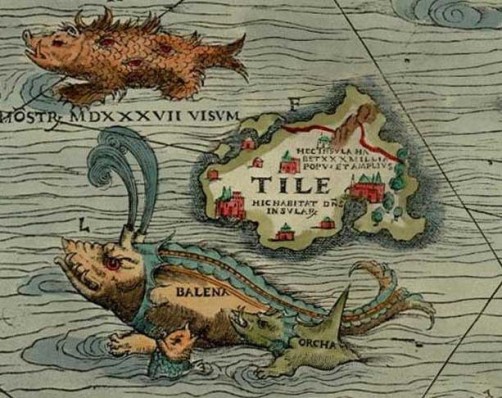
Carta Marina (detail) 1539, by Olaus Magnus, map of Scandinavia.
“Institutionally, social services developed out of the bourgeoisie’s need to stabilize the forces of capitalism and white supremacy. US industrial capitalism’s tendency to consolidate and monopolize threatened to undo the white supremacist system of African chattel bondage. The Homestead Act of 1862 was in a way a “social service” legislated in response to the displacement of white farmers and the inability of industrial capital to provide full employment to the white proletariat. This Act gave government subsidies and land allotments to White Americans and European immigrants, provided they settle West of the Mississippi river. To pave way for White settlement, the US government brutally displaced the Indigenous nations in the region.”
Danny Haiphong
“I can think of no street in America,
or of people inhabiting such a street, capable of leading one on towards the
discovery of the self. I have walked the streets in many countries of the
world but nowhere have I felt so degraded and humiliated as in America.”
Henry Miller
Tropic of Capricorn
“The Chartist working-men, on the contrary, espoused with redoubled zeal all the struggles of the proletariat against the bourgeoisie. Free competition has caused the workers suffering enough to be hated by them; its apostles, the bourgeoisie, are their declared enemies. The working-man has only disadvantages to await from the complete freedom of competition.”
Friedrich Engels
“This boy rows as well without learning as if he could sing the song of Orpheus to the Argonauts, who were the first sailors.’ He then turned to the boy. ‘What would you give, my lad, to know about the Argonauts?’ ‘Sir,’ said the boy, ‘I would give what I have.’ Johnson was much pleased with his answer, and we gave him a double fare. Dr Johnson then turning to me, ‘Sir,’ said he, ‘a desire of knowledge is the natural feeling of mankind: and every human being, whose mind is not debauched, will be willing to give all that he has, to get knowledge.”
Boswell’s Life of Johnson
The topic of education seems to be coming up a lot recently. And I think its probably time to approach the idea more fully. I remember while teaching at the Polish National Film School, in Lodz, I once asked at a faculty meeting ‘what are we trying to do here?’ There was a long awkward silence after that question. And that is because it is assumed we all know, all teachers somehow magically know what they are trying to do.
The history of the Chartists in England, in the first part of the 19th century, is useful to re-visit now I think. The debates over “really useful knowledge”, the wisdom of allowing the working class to even open a book, were much debated. But there were debates around the idea of free schools, that teaching neednt focus on the development of practical knowledge, that which was supported by business owners, but rather on political science, philosophy, and the arts.
Victor Neuburg wrote: “Among outright opponents of the idea of charity schools was Bernard de Mandeville, author of the Fable of the Bees, which included in its 2nd edition in 1723 an “Essay on Charity and Charity-Schools”. ……… the points he make are that (a) the poor do not need any education; (b) if they have learning, they become too proud to work; (c) education makes servants claim higher wages while at the same time they do not want to do servile work; (d) though it might
be reasonable to teach reading, the teaching of writing cannot possibly be
justified. De Mandeville’s thesis was a sociological and economic one: no nation
can be great without vast numbers of ignorant people to do the drudgery.”
In the House of Commons in 1807, a speech was given declaring education for the working class would teach them to despise their lot in life. John Stuart Mill, later in 1867, was carrying on this debate when he spoke at St Andrews University:
“Universities are not intended to teach the knowledge required to fit men for some special mode of gaining their livelihood. Their object is not to make skilful lawyers, or physicians, or engineers, but capable and cultivated human beings.”
I mention these points because the debates today about public education tend toward financial concerns, tax subsidies, and less often about what might be the essential point of teaching anyone. The fear of the lower classes learning ‘too much’ has been operative since the late 1600s, and is operative today. The first system of graded education for children, from six to fourteen, was in Scotland in the early 1820s under David Stow. There was a limit placed on this and all subsequent systems, and that was, the kids were to return to work at age fourteen. The teaching was basic reading and writing, and a few practical skills. Education has always born the imprint of class. When the mainstream media today frames discussions of Ferguson Missouri, they do so (and so does the ever offensive Bill Cosby) in terms of the failure of the poor to raise themselves by their bootstraps. Why can’t they speak “proper” English? I know that when I went to school, the clear message was to NOT strive too high. The education was degraded and, more, the education in socializing was non-existent. I knew nobody expected anything of me. And I was white. My family lived on food stamps often, but we still had some advantages that many never get.
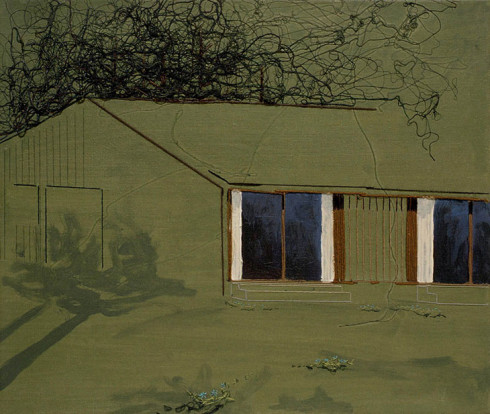
Michael Raedecker
I’ve always been fascinated with maps. When I lived in London for a short while, I used to visit this great map store and even purchased a huge map of Antarctica, which I had on my wall there, and later on a wall in my loft in L.A. One of the things one realizes about maps is that they contain an ideological imprint. From the early 17th century onwards cartographers were bent on creating a scientific standard of geographic knowledge. One that showed a standard relational model of the natural world. But of course what this really meant was to create ‘rules’ which everyone would agree upon (everyone meaning European Imperialist powers). This meant *other* mapmakers were going to be marginalized (as were their societies) and that this new standard was going to tie the mimetic imagination to a ‘standard’. As J.B. Hartley wrote; “(this)enabled cartographers to build a wall around their citadel of the *true* map”.
What is the white map of places like Ferguson, Missouri? In what way is ‘space’ in general taught today?
“Twenty years of disinvestment and impoverishment as Ferguson became a majority Black city have taken a visible toll.
As soon as you pull off the Interstate into town, there is a strip mall that stands completely dark. Payday loan companies have set up shop on almost every corner. The notice for a free adult clinic on Saturday hangs from the sign of a business that has been closed for a while.
The ditches that line the streets to help alleviate flooding from the Mississippi River were carefully built and reinforced with concrete a long time ago, but they’re overgrown with brush thick enough to block adequate drainage–even though the town is just minutes from the riverbanks.”
Trish Kahle
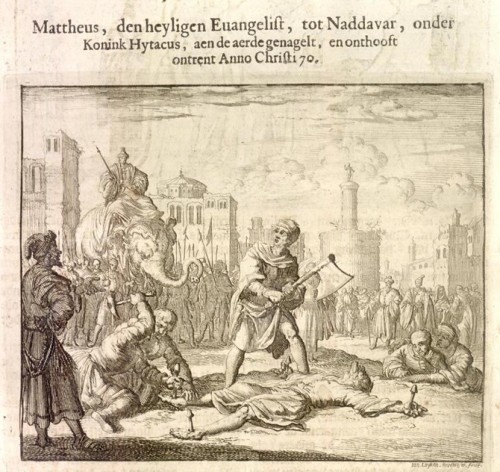
Jan Luyken, 1694, Evangelist Matthew beheaded, Naddavar, Ethiopia, AD 70.
I have often wondered at how artworks, fiction and theatre and film shape our sense of mapping the world. We are very dependent now on maps to coordinate our spatial thinking. I know I have driven around central Norway where I live at the moment and thought, I’m sort of lost, I have to look at a map when I get home to understand how I ended up on the other side of the lake. Now, I’m not really “lost”, I just don’t have a clear picture of a map in my head. I often feel I cannot understand fully where I am until I have consulted a map.
Additionally, of course, there is the largely ignored legacies of earlier cities and landscapes. The role of colonialism plays into this. And colonialism is not taught. And having grown up in Los Angeles, I think I, personally, developed a very skewed sense of city space. Edward Soja for example calls Orange County (just South of LA country, north of San Diego) a simulation of what a city should be. He calls O.C. an *exopolis*, and a simulacrum. A decade earlier Mike Davis wrote the definitive history of El Lay in City of Quartz. He was also the first to analyse the new fortified city, the securitized urban space. And Davis, like me, is a native of Los Angeles. What I am interested in here, though, is the sense of inherited biases, and assumptions, and the constant thrum of Hollywood product. So in a sense we have both an intensification of authoritarian spaces, and building, an amnesia regarding colonialism and Imperialist history, as well as, really, all historical forces of building and mapping and depicting that building. Third, there is the shrinking narrative.

David Thorpe
Now in a week in which resistance formed against openly racist police, and militarized police, in Ferguson Missouri, it is worth again examining how not just maps, but how narratives are constructed in the advanced (sic) West and how those narratives play a role in how people relate to and build the world around them.
“The sense of entitlement exhibited when white Ferguson police officer Darren Wilson shot the young Mr. Brown combined the impunity of racial privilege with a pathological indifference toward the person of Mike Brown, his family and his community. Whatever the personal failings of Darren Wilson, it was in his official role on the Ferguson police department that he murdered Mr. Brown. Around the country the appearance of the police as invading armies in poor communities of color is because that is what they are. As the late Huey Newton put it nearly a half century ago, the police aren’t in poor communities to protect property because poor people have no property to protect.”
Rob Urie

Johannes Kahrs
The affluent class looks at Ferguson as a place with only potential property, perhaps at some future date we can develop this area. This is a homogenized and generalized landscape. The wealthy whites who view Ferguson tend to view it from afar. That distance is built into the sense of foreigness it holds for them. It would be interesting to survey Hollywood film and TV to see of all the cop shows produced in the last twenty years, or thirty, and count the number of scenes of *ghettos*, and of poor, black and latinos living in these areas, how many are filmed at night. And compare that to how many times trailer parks with poor whites are filmed at night vs day. I would guess, and this is only my impression, that ghettos are mostly filmed at night and as shadowy threatening landscapes. Trailer parks are mostly shot during the day, or least its sort of evenly split between day and night. Now, one could also ask how many times are cities themselves, in crime drama, shown at night? And odds are in crime narrative the night wins out over the day. But the inner city, the ghetto, is exclusively, almost, filmed at night. The association is with the heart of darkness, with threat, with the unknown. For most of white America has not been to black neighborhoods very often, if at all. The night is also more erotic. Illicit sexual adventure takes place at night. So, perhaps its the quality of night being depicted.
And here is might be worth remembering the Frankfurt School critique, at large, of the Enlightenment. The idea of scientific practice was one carried out without regard for the purposes it served (to paraphrase Horkheimer). Of course under the driving force of Capitalism, science became increasingly mediated and by extension so did University research, and government funded research. Horkheimer wrote: “the world of objects to be judged is in large measure produced by an activity that is itself determined by the very ideas which help the individual to recognize that world and grasp it conceptually.”
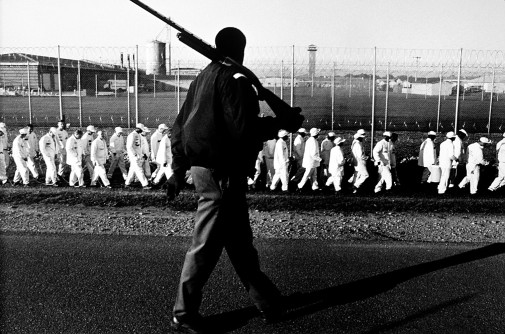
Andrew Holbrooke, photography. Limestone Correctional, Alabama, 1995.
The cultural drive over the last thirty years has been one of acute militarism. Research is linked to the Pentagon, funding is linked to war and weaponry. So, cutting across this production of space is the eye of the conqueror. If 17th century cartographers saw through the eye of God, the digital mapmakers of today see through the literal lens of surveillance and stealth. The city today is completely surveilled, except in its frontier regions, the poor ghetto and barrio areas. The slums. So, these un-digitalized areas are generalized, abstracted, and peopled with demons and pathogens. The colonial overseer is now called “officer”, or social worker. The bureaucracies of power all see the poor as a problem, not a problem because they suffer, but a problem to those viewing them, because of the discomfort they cause. No more telling remark was ever made by the ruling class than by Barbara Bush when the topic of body bags was raised: “… why should I waste my beautiful mind on something like that…”. She of course also said the Hurricane Katrina homeless and refugees, being kept in the Astrodome; “And so many of the people in the arena here, you know, were underprivileged anyway, so this is working very well for them.”
Again from Trish Kahl’s excellent piece at Socialist Worker:
“The city of Ferguson, just north of St. Louis, has a population that was, as of the 2010 Census, 67.4 percent Black and 29.3 percent white. Yet whites account for five of Ferguson’s six city council members, and six of seven school board members (the seventh member is a Latino). Out of 53 officers in the Ferguson police department, there are three African American.”
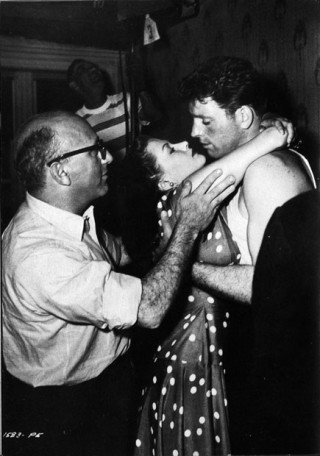
Robert Siodmak, directing Criss Cross, 1949.
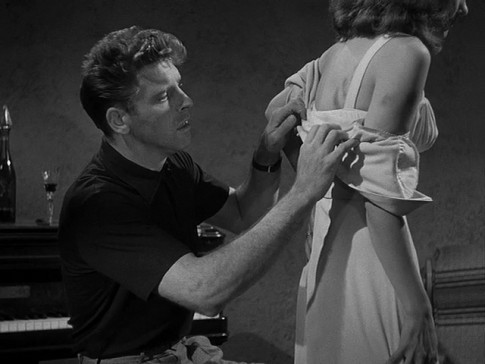
Criss Cross (1949), Robert Siodmak dr.
For even in True Detective, which had the virtue of depicting a landscape of genuine American poverty, the narrative pov is not that of the impoverished. It remains, although mediated, identified with with those who hold the power. These are still cops. I’ve always felt much of the bourgeois feminist criticism of noir, of femme fatals misses the point of the feminized male protagonists. For again, the real narrator isn’t the narrator, it is the camera, and in that sense, those 1940s noirs lent themselves most acutely to auteur analysis. One could argue that neo noirs like L.A. Confidential are far more misogynist and defined by hyper masculinity. The shift from subjective to inauthentic realism occured mid 50s, and was solidifed by the end of the 60s. But I want to return this to another aspect of these narratives, and that is the default setting or backdrop of authoritarian space.
For without a grasp of the colonial perspective of popular culture today, pedagogy cannot really advance in the arts.
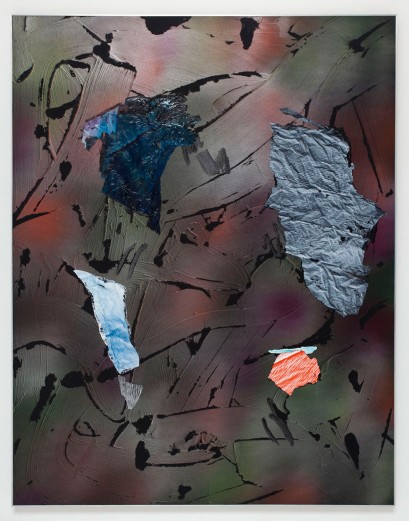
Joe Rehison
“What psychoanalysis suspected, before it became itself a part of hygiene, has been confirmed. The brightest rooms are the secret domain of faeces…No science has yet explored the inferno in which were forged the deformations that later emerge to daylight as cheerfulness, openness, sociability, successful adaptation to the inevitable, an equable practical frame of mind.”
Adorno
This was Adorno’s almost prophetic critique of Lacan, before Lacan existed. Adorno suggested a kind of almost prehistoric intervention that neutralizes the opposing forces of our psychic development. One that is an apriori triumph of submission to collective authority. A process immune to knowledge. He felt a great distrust of exuberance, and saw only self embalment. The mirror phase may well now be short circuited before it begins, so deep is the patterning of authority, and the insistence on mental retreat. The new culture industry product has completely colonized the narratives of today’s Western societies. There is no questioning of the social environment we live in. Our maps are the maps of a digitalized depthless perspective in which pathological brightness and loud noise have succeeded in elimating the space for calm reflection. The constant *dead now* is reproduced every nano-second. Films like Criss Cross feel different because, partly, because of the faces in them. All great film directors intuitively grasp the significane of the human face. But in an era adjusting to the new biometric surveillance systems, to botox and other plastic surgery, to steroids and photoshop, the human face is disappearing. Pasolini, Antonioni, Fassbinder, and those German emigrees, filmed a vanished world, a place where pain passed over a countenance like dark clouds over a sunny picnic. Faces that betrayed secrets. And perhaps this extends to the movement and gestures of the actors. Lancaster possessed a physical grace I find hard to imagine today. Brando had that as well, the young John Wayne.

Peter Kayafas, photography. Telega, Romania 2005
I wanted to try to link together some of this, and its useful, I think, to return to maps. The ethnocentric map is a well known concept, meaning putting your nation state at the center, or from a system that enlarges your own territory. Maps also includes subtle vocabularies or codes for relating comparative importances. Even basic tourist maps will provide *points of interest*, meaning places to shop, or worship authority. Maps are only another medium for sustaining social dynamics, social rules, and hierarchies of power.
And this is true, and maybe even especially true, of scientific maps. So to extend this understanding of cartography to, say, Ferguson Missouri, one sees the simple profile of most impoverished areas of the country. Discount everything, including food and medicine.
Here is a list of businesses in Ferguson;
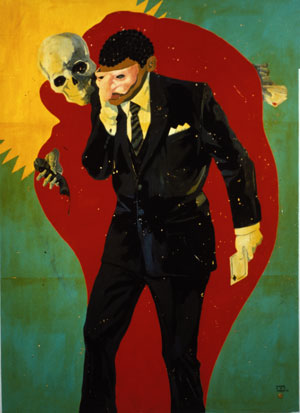
Michael Ray Charles
Church’s Chicken
Nike
Cricket Wireless
Popeyes
Curves
RadioShack
H&R Block
SONIC Drive-In
Jones New York
Steak ‘n Shake
KFC
Subway
Little Caesars Pizza
U.S. Cellular
McDonald’s
Walgreens
This is a grim list. The jackals of franchise buisness. Compare to any upscale neighborhood in the country, predominantly white, and the differences are clear. That such poverty, such acute inequality, can exist side by side, often, with wealth, is something missing from entertainment narratives, largely. Oh, those MFA programs turn out fiction about the poor, but my sense is that usually this is a poor that occur in a vacuum. But perhaps it is more than that, because these are generalizations. It is the less than obvious codes and grammar of privilege, of paternalism. And there are also an awful lot of MFA writing programs out there. The problem with most arts education is that is emphasizes innovation and originality. D.W. Winnicot said, “originality is impossible except on the basis of tradition.” And there is more freedom in sonnet form than in free verse. More in sonata or any other strict structural form. But there is no ‘originality’, its now am empty term. It is worth noting that dissent does not fall under original. The admonition in early schooling for cheerfulness and friendliness is part of the inherent sadism of the Puritan patriarch. Later, there is the admonition for being original AND friendly. And throughout all of it is the mandate for sociability. Keep your mouth shut, smile, and accept any and all suggestions. Success means learning not to make waves. Tradition recedes ever further behind us like some road kill in the rear view mirror.
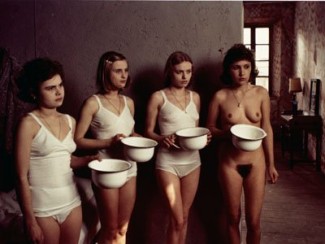
Salo, (1976), Pier Paolo Pasolini dr.
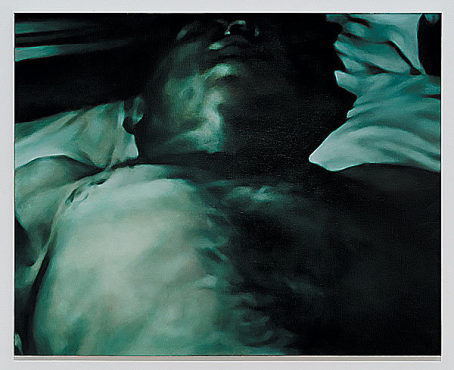
Judith Eisler
The idea that Jameson put forth, the death of the subject, is worth an entire posting, but one problem it seems to me is the fetishizing of technology and mechanical reproduction. For that reproduction hasnt at all eliminated the distinctive brush stroke (his example, or one of them). It is only distinctive in another way. There has also been no liberation from anxiety. The problem is that feelings are not ad hoc eliminated, but are part of a systematic intensification of societal domination of every kind.
Jameson does then contradict, or not quite contradict, his earlier statements :
“The technology of contemporary society is therefore mesmerizing and fascinating not so much in its own right but because it seems to offer some privileged representational shorthand for grasping a network of power and control even more difficult for our minds and imaginations to grasp: the whole new de-centered global network of the third stage of capital itself. This is a figural process presently best observed in a whole mode of contemporary entertainment literature — one is tempted to characterize it as “high-tech paranoia” — in which the circuits and networks of some putative global computer hookup are narratively mobilized by labyrinthine conspiracies of autonomous but deadly interlocking and competing information agencies in a complexity often beyond the capacity of the normal reading mind.”
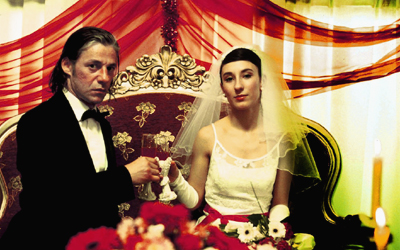
Head On (2004), Fatih Akin, dr.
This much I think is true. The issue is one of prescriptive and descriptive I think. The *waning of affect* is correct if we compare Rembrandt with Warhol, but far less true if we compare Rembrandt with Daniel Ludwig, for example. It is true enough however that today’s Western population can no longer make sense of their inner life, and consequently have an increasingly difficult time making sense of the state of the ‘other’. This is why I continue to suggest the collective now mimics one end of the Autism spectrum. Though Im also inclined now to see it as something far less complex than autistic processing. The waning of affect means the loss of allegory. In a culture of sampling, history is always solipsistic. The blurring of high and pop culture has resulted in everything becoming genre. And I’m not sure, in the end, this is regressive. The problem with the new subjectivity is the myth attached to it, the ‘family of man’ ahistorical which becomes, in different forms, a kind of fascism (and this was close to Heidegger, actually). The individual still suffers, and *difference* includes class and history. And no further proof of that is needed than Ferguson, Missouri.
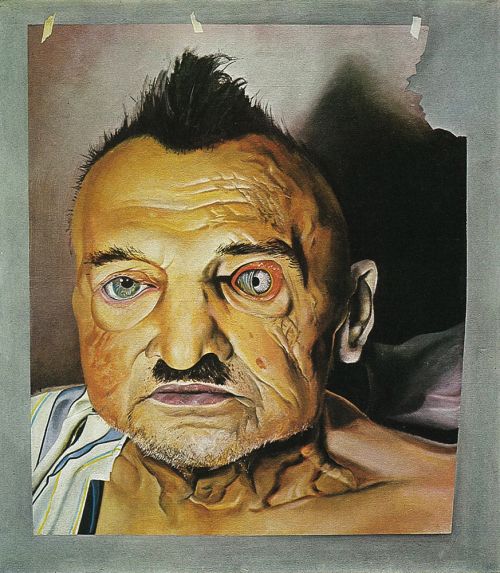
Wolfgang Petrick
It is at this point that Althusser makes very cogent points, that ideology creates *a* subject, the one of the shrunken inner life, the one who has trouble understanding the world unless comparing it to Breaking Bad. As Judith Butler put it: “Power, that first appears as external, pressed upon the subject, pressing the subject into subordination, assumes a psychic form that constitutes the subject’s self-identity.” This is not ever a total subordination, because everything is dialectical, and additionally it happens in degrees, incrementally. But the crucial aspect of this, for aesthetics and pedagogy, is the idea of negation. The whole is untrue, said Adorno. Those master narratives Lyotard and others (Derrida for one) found so obsolete, culturally, are only to be refashioned as narratives of negation. There is work, even in film, that is doing this. The Turkish/German production, Head On, directed by Fatih Akin (2004) is one recent example. Stranger at The Lake, Blue Caprice, A Prophet, Mister John, and Dogtooth. There are others, certainly. Aesthetic resistance matters, and without it, the slippage in critical judgement means that mass culture will intensify their adoration of junk (Boyhood, Zero Dark Thirty, The King’s Speech, etc) and fawn over the surrogate imperialists at VICE who pose as journalists, or from the likes of Laurie Penny and Crabapple on the branded left, those exclusive white kittenish hipster reactionaries. The sclerosis of much of the longtime left, especially in matters of art (see Proyect on film) is now painfully obvious. The death of the subject is rhetorical. We wouldnt be writing and reading this blog for example, if it were literally true. What was always a myth was really the implied superiority of a certain class.

Great post as usual. And regarding your question about what makes True Detective different from 40s noir, even though both were mediated as studio products, I have a hypothesis: studios during the golden age of noir were owned by executives and producers who were almost all life-long filmmakers who have gradually risen to the top of the corporate structure. So as profit-driven as they were, they still retained a basic respect and competence in the craft they grew up in. Nowadays, in the executive boards of the major media companies, you’ll be hard pressed to find a single person who’s a movies guy/gal born and bred. Because sometime in the past decades, there was the new MBA mentality that somehow “business ability” was this separate ability that had no connection to the actual industry. That a “good entrepreneur” should be able to abstractify his entrepreneurship (entrepreneurship became a commodity, really) and bring it anywhere, whether it’s energy or telecommunications or cars or movies (or the military and prisons). Ford Motors stopped being run by people who grew up designing cars and instead by those who’ve never set foot inside an assembly line. And the same thing happened with film. Nowadays you’d have Sony executives who only know numbers and investment portfolios sending in memos into the writer’s room dictating how the story should be told. And so, even the basic craft is completely eroded.
Also, the sheer size of corporations built on decades of consolidation means that film as an industry is almost always dictated by non-film interests, even on a business level. A media company is now going to be a conglomerate of everything as diverse as materials to electronics to energy to military, answering to the same shareholders. The days of a film studio being just a film studio was gone.
A historical example I like to give as an analogy is Shakespeare, because the distance of time really puts things in relief. Shakespeare was not ignorant of business — in fact, he was unusually competent at business for a playwright of his time. But at the same time, The Globe was JUST the Globe — it wasn’t funded by the same money as Queen Elizabeth’s Navy. Shakespeare and his co-actors like Richard Burbage, true artists all, owned the shares of the theatre. It was really more of an artist’s cooperative. (Now of course the patrons mattered, but less financially and more as political protection.) He didn’t have to answer to a memo from the East India Company. And though censorship was quite heavy, the number of staff in the “censorship bureau” was 1.
That’s why I think your point about form vs content is very crucial, actually. Shakespeare’s company would have had to cater to the audience to some extent, content wise — and his plays DID. But it’s the *form* where his true depth and artistry showed, and there was no overwhelmingly powerful interest to dictate the form down to the smallest detail.
I really like your Jameson quote, and if I’m reading it correctly, it relates to the hegemony you write about, one that includes the MFAs, and your critique of the Enlightenment project vis. the Frankfurt School. It’s that we live in an age of gigantism, and the human subject is become neurotic and overwhelmed by tasks and input of information that no longer seems to be on a human scale. Institutions become Leviathans with lives of their own, or rudder-less ships, driven by forces too large to fathom. I keep going back to the idea of a resurgent medievalism, and I think it’s an accurate analogy. We’re like the monks of middle ages who have libraries full of classics, books piled to the ceilings, and yet have no idea where to start to make use of them or even understand them. And connected to that gigantism is the idea that we’re in an age of waste, unprecedented waste in every aspect: not just material waste, but also spiritual waste, waste of potential, wasting human lives on suffering without gaining wisdom. Because gigantism inevitably breeds waste. I’m not sure life has become more full of suffering since the Renaissance, but I do agree with the critique of the Enlightenment project to the extent that, as much as we’ve had an explosion in material wealth and technological development, we’re becoming much more wasteful in suffering. This is not at all to condone the barbaric conditions of a more authoritarian and aristocratic past (which is coming back anyhow), not to ignore the tremendous amount of slavery and class exploitation that the civilisation of the past was built on; but there is a sense that the aristocrats of the past were not nearly as wanton and as willfully perverse in their privilege. We are, in some senses, more cruel, because we HAVE the material conditions to give a comfortable life to all, and yet we don’t, we willfully waste it, nihilistically, not even for our own joy, or to create great cathedrals and marble sculptures that grew out of exploitation like a lotus flower out of mud, but simply because we *CAN*. That’s why our age is a crueler age than ever before, and that’s what makes our moral depravity so particular.
Regarding the problems of True Detective, form wise, I have my own thoughts. I loved it tremendously, but I do find it problematic.
1. The frame story of the two black cops interviewing the two white cops was surprisingly great and gimmick-free, especially as it introduces the constant device of having Hart and Cohle narrate an event that we then see shown on screen very differently. (And film being its deceptive self, we can’t *actually* be sure what is shown visually is more truthful than the voice over.) And this was echoed as well when we start seeing the same device extend to Maggie. The problem is that, first of all, the clear intent to use this structure to delve into deeper issues about race didn’t really pan out. There were a few attempts, in the interviews with black citizens, for example, or the black Christian congregation, but having walk-on characters *commenting* in the dialogue, doesn’t actually mean exploring. And more damningly, the structure is never pursued to its end. Ideally, when the structure of having a double-story starts spreading not only to the interrogation of the cop, but also to Maggie, towards the end of the series, it’s a cue that it’s begun to permeate the fabric of the whole fictional universe — that the hidden nature of the narrative, which was this doubling or mirroring, was being revealed, somehow. The ending should have culminated in a paradox, an ultimate enigma. Instead, it is all too literal. The Yellow King symbolised the Heart of Darkness that Hart and Cohle were battling (somehow), and hark, there he is, a literal monster in a literal cave, with a handaxe and shotgun to boot. We had Hart and Cohle facing the ultimate truth, and they did, they faced off the villain, but that encounter could only be explained one way. There’s no double-meaning, no mirroring, no face-vase or duck-rabbit, what have you. There’s just the guy with the scars.
2. Related to that is that the hunt for the Menace is too much like a treasure hunt. The structure is too episodic, and there’s no logical reason why the final chase could not have occurred 4 episodes earlier. Or rather, there was, but the reason was only as good as chasing a bread-crumb trail. Sure, if you’re chasing a bread-crumb trail, you’re going to have to pick up one crumb at a time, but there was no necessary reason why one bread-crumb had to follow another. It looked for a moment like Maggie’s affair with Cohle was going to be the place where the personal lives of the cops were irreversibly entwined with the murder mystery, but then the two threads fell apart very quickly because Cohle and Hart’s reconciliation 10 years afterwards didn’t feel like much of a narrative problem. I mean, the video tape of the ritual child abuse resigned Hart into helping Cohle stop the Menace, but are we seriously suggesting that Hart had not considered ritual child abuse was at least a possibility, from the very beginning of the case? Is the videotape really that much of a shock? It was too convenient, and it wasn’t solving a narrative problem, it was simply moving the plot forwards so that the series can end in episode 8.
Also, remember the neighbourhood that Cohle trashed during his semi-botched attempt at following the lead at the drug ring? (The gorgeously shot action-sequence with the breathtaking long takes.) Yeah, I would have liked to have seen some narrative consequences from that. It should have been, you know, the moment where we realize Cohle is as crazy as Ahab. But that was never dealt with as a narrative *problem*. Instead, it was given the same conventional treatment as almost all action movies do, which is to turn the neighbourhood into a mostly faceless mooks-ville that’s merely a canvas for the action.
Actually now that I think of it, I’m surprised the Moby-Dick comparison wasn’t made. I haven’t read any reviews even mention it, I don’t think.
I should have distinguished between a work of art being problematic, that is, having “not-good” parts, and the idea of a narrative that is problematic. It’s the same word but I mean it completely differently. I think that all narratives have to be “problematic” — that is, it should pose the human condition as a problem rather than a solution. When Cohle trashed that neighbourhood, there should have been some consequences, because he tampered with a human habitation; if there were no consequences, then the sequence fails to pose the human condition as a problem. It’s consequences — and in terms of form, this manifests as the inevitable drive that moves the plot to its only conclusion, the singular plot that Aristotle gives as the ideal in his Poetics — that represents, in some way, the idea of fate. In a story, formwise, plot is fate. Sophocles and Euripides were the epitome of that: they posed a fatalism without an answer. True Detective posed a fatalism with an answer. I found the conclusion to be like Dante’s Comedy, actually, the love that sustains the universe, or whatever. Let me look up the Longfellow translation… “The Love which moves the sun and the other stars.” And the last episode ended with a monologue on the night-sky. It’s uncanny, really. Nic Pizzolato taught literature. I’d be very very surprised if he *didn’t* self-consciously make that connection.
But that comparison flatters, and when I start comparing commercial entertainment to literary classics it’s probably a good sign to leave the topic for today 😀
@exir:
I think without going too deeply into this, that you’ve identified the tipping point in the story…speaking of true detective. That six minute single shot…….an amazing tracking shot, really, was also the first clear step downward into the underworld. That was Cohle’s leading the harrelson character downward with him….but in pursuit of the truth. TRUE detective….the point always seem to be in that title. The true detective is one searching for that which cannot be answered. There never is a heart of darkness. But again, this is the problem with a receding sense of metaphor and allegory these days.Pizolatto sort of tries to atone in the last scene of the show, with a speech about the unknowing darkness or some shit, but its not enough by then. That six minute single shot was galvanzing…and it portended of future self imolation….that purgatory awaited. And that was the strength of the show. The sense of everything being an antechamber to hell. But you cant just walk into hell, like they do in that barn or cave or whatever it was. The end of the show was really the episode that ended with them asking directions from the strange man on the lawn mower. That was the end. They’re lost. They shall remain lost. And that figure mowing the lawns of an abandoned estate was like the boatman on the river styx. But he’s not letting you cross. Not yet.
As for your analysis on film noir. Yeah, i think thats mostly true. Aldrich and fuller were copy boys, others came by way of strange professions outside movies (Boetticher was a bull fighter )…..there were no film schools. There was apprenticeship. Now its all business school producers and film school directors.
Perhaps only for the sake of being hypothetical or what have you, I’d like to ask why attending a university or an academy for an artist of any medium to learn a craft is a bad thing. Most great painters into the 20th century were classically and professionally trained at art academies and such. The same applies to classical composers in the 19th century. It functioned as a trade almost. They learned their craft as if they were trained artisans and mastered it from there. Most of the great Eastern European filmmakers, including Tarkovsky attended film schools, as well. They had to have a certification if they wanted state funding to make their films, and that was the only way one could get films made during the Communist era. I’ll be the first person to slam MFA programs and film schools in their current incarnation, but hypothetically, I certainly don’t see classical training at an art academy as a bad thing, especially since so many great painters throughout history including some 20th century abstract painters had their start that way.
the film schools under communism were utterly different both in intent and in influence. Secondly, the great filmmakers of europe did not all attend film school. Fassbinder didnt, he came to film from theatre. Pasolini didnt, he began as a poet, and studied philology at university. Mizoguchi didnt, Ozu didnt…but then they didnt have film schools back then. Antonioni worked as newspaper journalist…didnt go to any sort of film school, nor did Bergman, who began in theatre. Losey didnt, he began in theatre, as did welles. So, no, actually none of the great directors went to film school. Herzog and Schlondorff and wenders….well, Wenders flunked his entrence exam to film school in france and went to work for an engraver. Herzog made documentaries for NASA, after leaving University (not film school)…and Schlondorff studied political science at the sorbonne. Godard wrote criticism, etc etc, Polanski went to the Polish film school where i taught, as did Skolomowksi (who never completed his degree)…so there are those two, but thats a very different sort of school, trust me. So…aside from today’s commerical directors NONE went to film school. Aldrich, sam fuller, et al…..Lang and those apprenticed at UFA…but thats not film school. You know who DID go to film school? The coen brothers. I dont know about the dardenne brothers….but milos foreman studied screenwriting in Prague at the academy of performing arts. Haneke studied philosophy in Vienna…..never went to film school, but did write film criticism.
Now I don’t how readily this relates to the discussion, but I do feel that both the film canon and the art canon, and by ‘art’ I essentially mean painting and sculpture, are more heavily enslaved to bourgeois modes of thought, since both mediums are more directly mediated by capital than literature or music. With painting, there’s the consideration of an non-reproducible aesthetic object that doesn’t factor in with literature or with jazz. Even a “non-commercial friendly” painter like Anselm Kiefer is going to expect a large chunk of cash for each painting sold or hung in a gallery. Bourgeois taste has always dictated the order of the day when it comes to ‘art’, even within the ‘high brow’ realm, due to the non-resolvable issue of ownership of the non- reproducible aesthetic object. That’s not an issue with novels. The whole idea of owning works of art, whether they’re genuinely great or not, is bourgeois to the core. There’s nothing necessarily bourgeois about owning a $15 copy of Ulysses. I don’t know how to consolidate my thoughts on this issue otherwise, but I’ll keep trying.
“Secondly, the great filmmakers of europe did not all attend film school.”
I never said they did. I was simply attempting to make a point about the hypothetical idea of receiving formal training in one’s chosen medium. Although it’s probably worth mentioning that some of them did apply to “prestigious” film schools but were rejected, and this includes Fassbinder and Godard. They, of course, went on to produce impressive bodies of work regardless.
but secondly; who said apprenticeship or training was bad? not me.
remy….if you have a point Im missing it.
“but secondly; who said apprenticeship or training was bad? not me.”
Well then maybe it was just a misunderstanding. I guess I was simply trying to avoid having the baby thrown out with the bathwater when you began talking about MFA programs and film schools. But I misunderstood you and jumped to conclusions. My apologies.
But perhaps what I’m saying is all great artists have to on some level embrace the cultural and even economic realities of their time. All great art is mediated by capital, although some works more than others. You need to rely on the system to be heard while at the same time undermining it. That’s really what a great artist must do, rely on the system in order to undermine it, so if someone chooses to be a novelist instead of a poet I wouldn’t say in every instance they’re selling out, but rather they’re choosing the best way to benefit from the system, in order to attack it. Artists don’t exist outside the system, or at least I don’t think so. Now many may just sell outs, for sure, but some I think are just embracing cultural realities. Godard may have been a genuinely radical voice, and he was, but he was also in the right place at the right time.
Robert Bresson, for example, began as a painter before going into filmmaking. Likewise Maurice Pialat. Now is it possible they chose to go into film, since they felt they’re chances of succeeding as painters were next to nil perhaps given the zeitgeist of their respective times and what not? Maybe. It’s possible, although I don’t know for sure. But if that’s the case, that they chose film over painting in the end given it had a better chance of bringing them a relative level of success and peer recognition should that in any way be held against their ultimate artistic accomplishments?
Someone may be drawn to poetry or sculpture, but they may ultimately realize they can more easily and freely express themselves with a camera or through prose instead of verse. Sometimes it’s just a matter of convenience.
Speaking of landscapes, urban planning, and traces of history:
http://www.theguardian.com/artanddesign/architecture-design-blog/2014/aug/25/front-facade-bad-developments-ruining-historic-buildings
More, on brutalizing students with those kinds of architecture:
http://www.theguardian.com/artanddesign/2013/aug/29/carbuncle-cup-student-housing-ucl
Like I mentioned in my earlier long post, completely banal and gratuitous cruelty.
those are great links, Exir. Thanks. And very much in line with a lot being discussed on this blog. Amazing.,